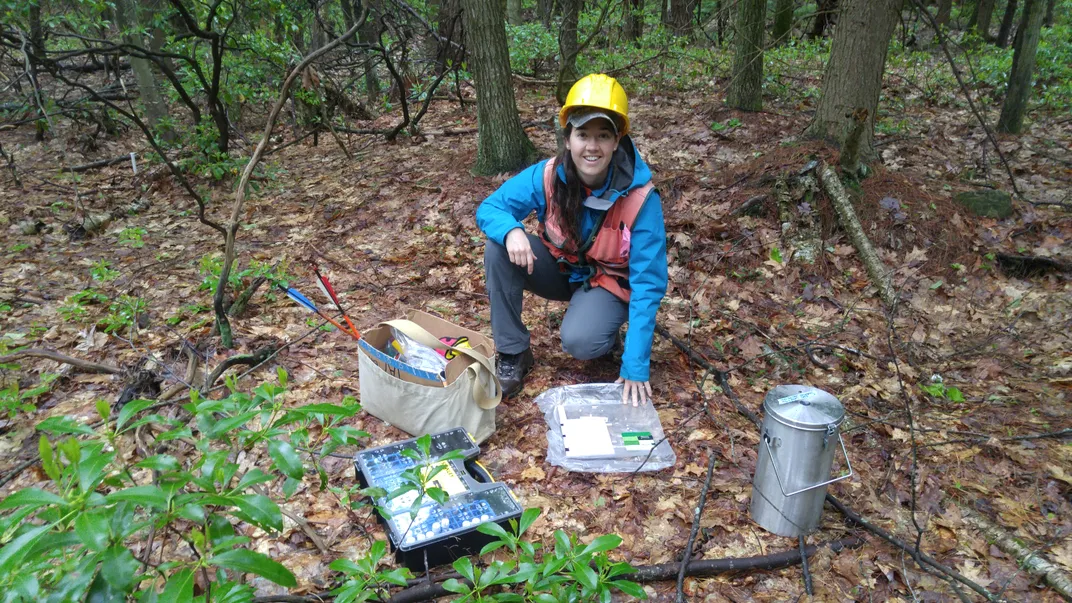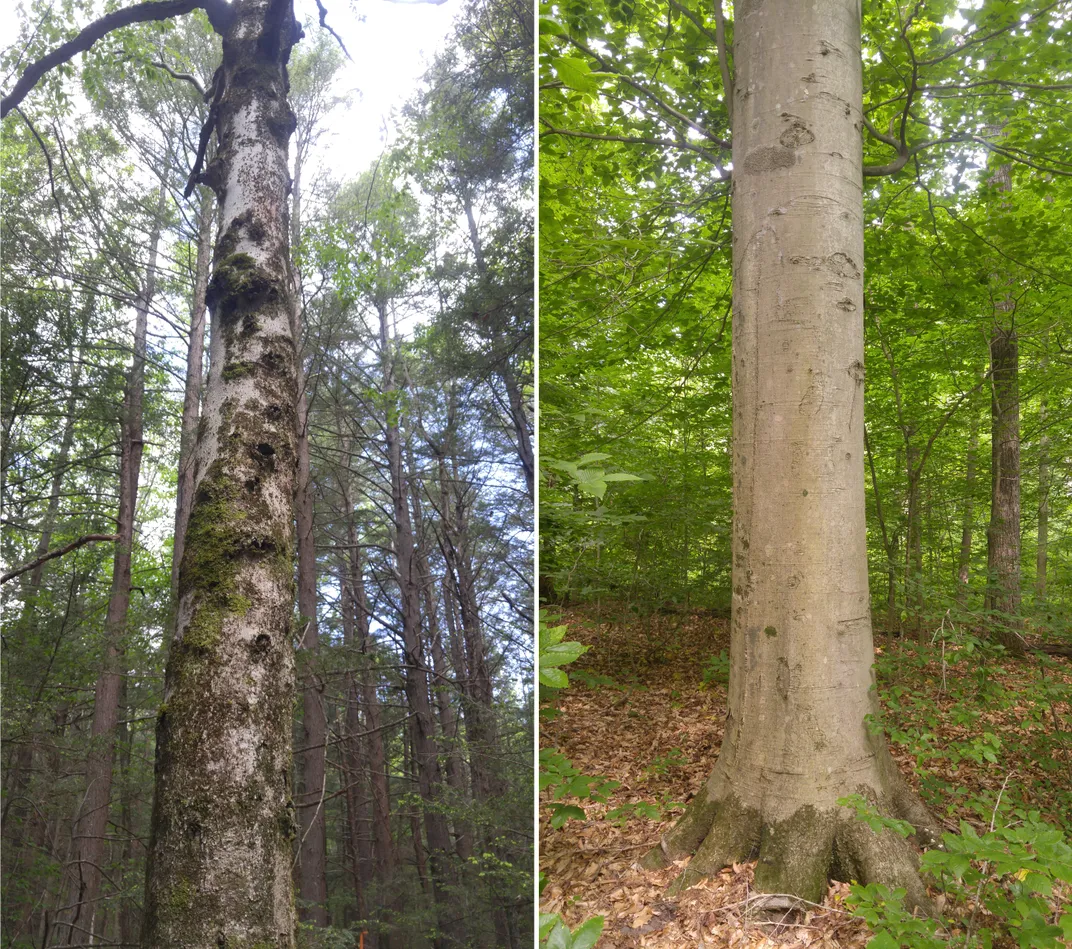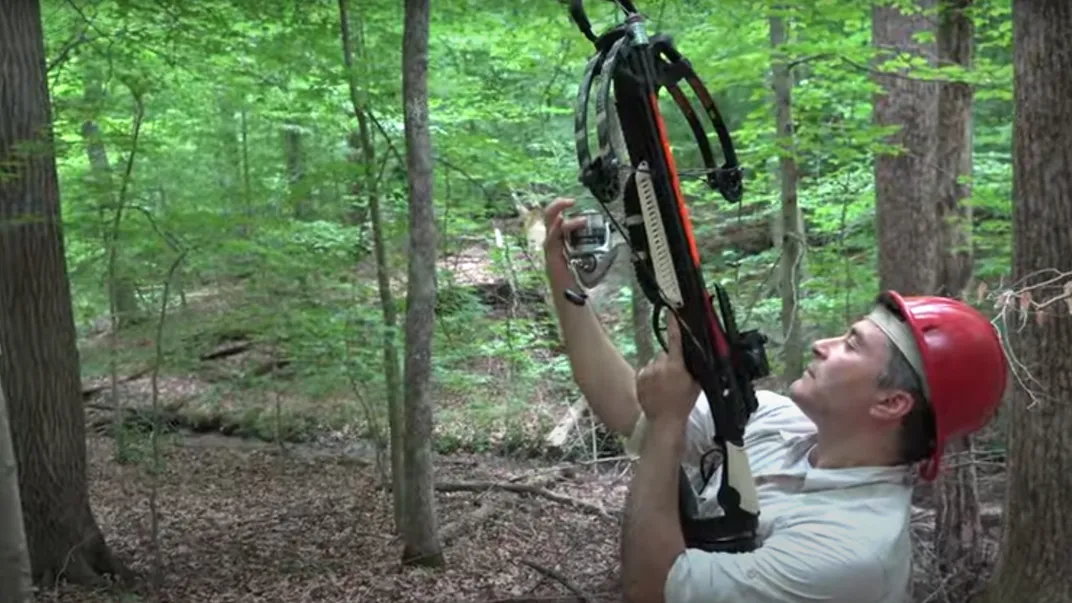SMITHSONIAN ENVIRONMENTAL RESEARCH CENTER
How Crossbows Can Tell Us Which Genes Trees Are Turning On…and Off
What’s a scientist to do, when you need to reach the highest leaves in the forest and a giant crane isn’t an option? Learn to use a crossbow.
:focal(2327x1568:2328x1569)/https://tf-cmsv2-smithsonianmag-media.s3.amazonaws.com/filer_public/80/57/80579c35-cbdd-477a-be16-af90283afbda/uzay_with_crossbow_photo_courtesy_uzay_sezen.jpg)
Nearly every beech tree in Harvard Forest is sick. A fungus called Neonectria is attacking their bark, leaving it pockmarked, gnarly and coated in fruiting spores that look like angry zits. And it’s trying to steal their sugar. But the trees are fighting back.
To make that discovery, biologist Uzay Sezen spent two years extracting genetic material from beech leaves. For comparison, he also looked at healthy beeches in a forest at the Smithsonian Environmental Research Center (SERC) in Maryland, his home institution. The work was part of a new study published this spring in Proceedings of the Royal Society B.
“What is it Harvard Forest trees are doing differently, in order to survive that chronically diseased state?” Sezen asked.
Crossbow Ecology
Sezen worked with a team of scientists studying the two forests in Massachusetts and Maryland. Armed with a crossbow and liquid nitrogen, they shot down leaves from the forest canopy to analyze the activity of their genes. Their goal: Find out which genes beech trees were switching off and on during two full growing seasons, spring through fall.
The easiest way to get at a tree’s gene activity is through the RNA in its leaves. RNA molecules appear whenever a gene is triggered to make protein. Unlike DNA, the famous double-helix molecule genes are made of, RNA can tell us which genes are actually doing something. But beech trees can grow over 80 feet tall. Enter the crossbow.
Sezen got the idea while working with palm trees in Costa Rica.
“A palm tree is a very, very difficult tree to work with genetically,” Sezen said. “I tried to extract DNA from roots. It was horrible. I tried to extract DNA from its stem….Even the chainsaws can't cut it. And the only tissue that was accessible to me was leaves.”
Fortunately, one of his field assistants had used crossbows to help people climb tall trees, by firing a guide line which they later used to establish a climbing rope. He taught Sezen to use a crossbow. Together they made some adjustments to shoot down palm leaves, by modifying the bolt tips and weighing them down with a screw and washers.
Those adjustments also included extra safety precautions, like hard hats. And the team made sure to tread carefully whenever someone was firing the crossbow, said Jess Shue, study co-author and SERC forest technician.
“No one would move forward until we could see where the bolt was and make sure we knew it had come down,” Shue said.

On Again, Off Again
Once the leaves hit the ground, the real genetic work began. The beech tree genome contains over 33,000 genes, which scientists at the Smithsonian, Notre Dame University, the University of Connecticut and Cornell University have worked together to decipher. But it wasn’t enough to know the full suite of genes that were present. The researchers also wanted to know which genes were “on” and “off.”
For a gene to be “on,” its DNA needs to get transcribed into RNA, which then churns out protein. Proteins kickstart all the activity inside an organism. If a gene doesn’t generate RNA and protein, it’s basically asleep unless something wakes it up. In scientist speak, the “on” genes are called the tree’s transcriptome.
“The transcriptome is what's actually happening in a moment,” explained co-author Sean McMahon, a SERC senior scientist. “What an organism is actually producing.” According to Sezen, the very same technology that enables us to sequence DNA also enables us to sequence RNA coming from active genes and build a transcriptome for every leaf sample.
For the sick trees in Harvard Forest, a few critical genes are helping keep them alive: the sugar genes. For trees, sugar is like oxygen. Roughly 3-4% of a tree’s sugar always needs to be flowing, or the tree will die. But the Neonectria fungus is also hungry for that sugar, Sezen said. So the Harvard beeches turned on genes that would keep their sugar away from the disease-causing fungus.
“The sugar transporters are super active, because you want to keep that sugar to yourself,” Sezen said. “You don't want to give that sugar to anything that is trying to scavenge it from you.”

Deluge and Drought
In total, the beeches activated over 4,000 genes during the two-year study. Spring was the busiest time, with more genes switching on and off.
Much of the activity revolved around an extreme event: the late, exceptionally wet spring of 2018. During a normal or dry year, trees preserve water by sealing their leaves with waxy molecules called “very long-chain fatty acids.” But fatty acids are expensive to produce. During the 2018 deluge, trees didn’t need to be so water conscious. Those genes turned off, so trees could invest in other priorities like growth.
“The trees were pretty much shutting down an entire metabolic process,” Sezen said. The extreme rain drenched both forests. But just two years earlier, Harvard Forest had also suffered a major drought.
“That is one of the problems of climate change,” Sezen added. “It feeds extremes.”
Up until now, few studies have looked at how natural, unmanaged forests behave at the genetic level. But as humanity continues to rely on forests—for food, lumber, medicine and a cooler climate—it’s crucial to understand how trees respond to extremes. By seeing which genes are active, or were once active and are now silent, we can capture those first responses. And then the trees can tell us when something begins stressing them out.
“We can have all kinds of definitions of what a drought is,” McMahon said. “But face it, if we’re interested in how trees respond to drought, then isn't a drought when the tree starts to respond to it? Because if the tree hasn't started to respond to lower water levels, then it's not a drought by the definition of the tree.”



